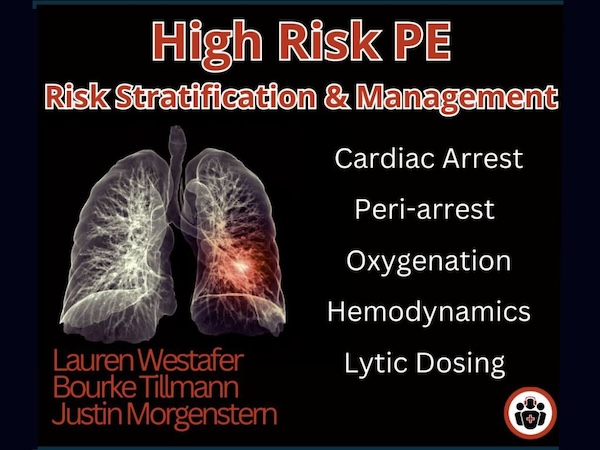EM Quick Hits 61 TEE in Cardiac Arrest, Nebulized Ketamine, Cellulitis Update, SQ Insulin for DKA, Medicolegal DDx Documentation Tips
Update: 2024-12-03
Description
Topics in this EM Quick Hits podcast
Ross Prager on TEE in cardiac arrest (1:05 )
Justin Morgenstern on nebulized ketamine for analgesia in the ED (26:27 )
Hans Rosenberg & Krishin Yadav on standardizing cellulitis management (32:48 )
Matthew McArther on latest studies on subcutaneous insulin protocols in DKA (40:04 )
Jennifer C. Tang on documenting differential diagnoses medicolegal tips (52:47 )
Podcast production, editing and sound design by Anton Helman
Podcast content, written summary & blog post by Anton Helman, December, 2024
Cite this podcast as: Helman, A. Prager, R. Morgenstern, J. Rosenberg, H. Yadav, K. McArther, M. Tang, J. EM Quick Hits 61 - TEE in Cardiac Arrest, Nebulized Ketamine, Cellulitis Update, SQ Insulin for DKA, Medicolegal DDx Documentation Tips. Emergency Medicine Cases. December, 2024. https://emergencymedicinecases.com/em-quick-hits-decemeber-2024/. Accessed October 28, 2025.
Transesophageal Echo - TEE in Cardiac Arrest - Resuscitative TEE
* Rational for resuscitative TEE and TEE in cardiac arrest:
* Provides real-time feedback on the optimal location and quality of chest compressions in cardiac arrest (precise location of chest compressions with respect to cardiac anatomy can be observed and manipulated to optimize circulatory flow as compressions directly over the LV have been shown to be most effective); ~50% of patients experiencing out-of-hospital cardiac arrest (OHCA) undergo aortic valve (AV) compression (rather than LV compression), obstructing blood flow. Absence of aortic valve compression during OHCA resuscitation is associated with an increased chance of ROSC and survival to ICU.
* Minimizes chest compression interruptions in cardiac arrest
* Allows identification of reversible causes of cardiac arrest - identification of obstructive pathologies including tension pneumothorax, cardiac tamponade, deep vein thrombosis with RV dilation suggesting pulmonary embolism, as well as filling status suggesting hypovolemia, pericardial tamponade, intracardiac thrombus, fine ventricular fibrillation, and to characterize the type of cardiac activity such as cardiac standstill or pseudo-PEA
* Provides prognostic information in cardiac arrest - LVOT opening as identified by TEE during CPR was associated with successful resuscitation in retrospective study
* For operators who are already experienced at using POCUS, Resus-TEE skills can be acquired rapidly.
* Procedural guidance:
* placement of an intravenous temporary pacemaker
* placement of extracorporeal life support cannulae
* Risks of TEE in cardiac arrest
* The risks of TEE are generally related to sedation & airway management. Critically ill patients who undergo resus-TEE are already intubated and sedated, thus these risks are minimized. There are risks of esophageal trauma with insertion, however these are probably comparable to the risks of gastric tube placement.
* Major complications such as serious oropharyngeal trauma, esophageal perforation, and major bleeding are rare with incidence rates between 0.01% and 0.08%
* Unclear if placement of the TEE in an emergent scenario or use during electrical defibrillations and chest compressions increase risk of damage to the transducer.
Ross Prager on TEE in cardiac arrest (1:05 )
Justin Morgenstern on nebulized ketamine for analgesia in the ED (26:27 )
Hans Rosenberg & Krishin Yadav on standardizing cellulitis management (32:48 )
Matthew McArther on latest studies on subcutaneous insulin protocols in DKA (40:04 )
Jennifer C. Tang on documenting differential diagnoses medicolegal tips (52:47 )
Podcast production, editing and sound design by Anton Helman
Podcast content, written summary & blog post by Anton Helman, December, 2024
Cite this podcast as: Helman, A. Prager, R. Morgenstern, J. Rosenberg, H. Yadav, K. McArther, M. Tang, J. EM Quick Hits 61 - TEE in Cardiac Arrest, Nebulized Ketamine, Cellulitis Update, SQ Insulin for DKA, Medicolegal DDx Documentation Tips. Emergency Medicine Cases. December, 2024. https://emergencymedicinecases.com/em-quick-hits-decemeber-2024/. Accessed October 28, 2025.
Transesophageal Echo - TEE in Cardiac Arrest - Resuscitative TEE
* Rational for resuscitative TEE and TEE in cardiac arrest:
* Provides real-time feedback on the optimal location and quality of chest compressions in cardiac arrest (precise location of chest compressions with respect to cardiac anatomy can be observed and manipulated to optimize circulatory flow as compressions directly over the LV have been shown to be most effective); ~50% of patients experiencing out-of-hospital cardiac arrest (OHCA) undergo aortic valve (AV) compression (rather than LV compression), obstructing blood flow. Absence of aortic valve compression during OHCA resuscitation is associated with an increased chance of ROSC and survival to ICU.
* Minimizes chest compression interruptions in cardiac arrest
* Allows identification of reversible causes of cardiac arrest - identification of obstructive pathologies including tension pneumothorax, cardiac tamponade, deep vein thrombosis with RV dilation suggesting pulmonary embolism, as well as filling status suggesting hypovolemia, pericardial tamponade, intracardiac thrombus, fine ventricular fibrillation, and to characterize the type of cardiac activity such as cardiac standstill or pseudo-PEA
* Provides prognostic information in cardiac arrest - LVOT opening as identified by TEE during CPR was associated with successful resuscitation in retrospective study
* For operators who are already experienced at using POCUS, Resus-TEE skills can be acquired rapidly.
* Procedural guidance:
* placement of an intravenous temporary pacemaker
* placement of extracorporeal life support cannulae
* Risks of TEE in cardiac arrest
* The risks of TEE are generally related to sedation & airway management. Critically ill patients who undergo resus-TEE are already intubated and sedated, thus these risks are minimized. There are risks of esophageal trauma with insertion, however these are probably comparable to the risks of gastric tube placement.
* Major complications such as serious oropharyngeal trauma, esophageal perforation, and major bleeding are rare with incidence rates between 0.01% and 0.08%
* Unclear if placement of the TEE in an emergent scenario or use during electrical defibrillations and chest compressions increase risk of damage to the transducer.
Comments
In Channel






















